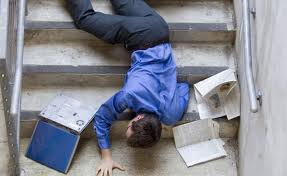Learning to balance is the best prevention against falls

Every day in homes and hospitals around the world, people old and young fall, and get injured. One thing that Australian Rules Football taught me to do, was how to fall without getting injured.
The report, “Hospitalisations due to falls by older people, Australia 2009-10”, shows that there were 83,800 hospitalised injury cases due to falls in people aged 65 and over in that year. This was more than 5,100 extra cases than in 2008-09.
70% of these falls happened in either the home or an aged care facility. The average total length of stay per fall injury case was estimated to be 15.5 days.
Balance is a highly complex phenomenon during which proprioceptive and vestibular signals are relayed to part of the brain called the cerebellum. There are many kinds of sensory receptors such as those that detect stimuli such as pressure, light touch, pain, position and temperature. Receptors also exist within muscles and joints.
There are many reasons for falling. These include simple mechanical trip, slip or stumble; balance disorders; visual problems; neurological diseases such as strokes, Parkinson’s disease and multiple sclerosis; musculoskeletal problems such as arthritis or muscle weakness; prescription drugs that may cause falls in blood pressure; alcohol; and illicit drugs; cardiac conditions such as rhythm imbalance.
Certain activities such as Tai Chi have helped balance in the elderly and in patients with Parkinson’s disease. Tai Chi has been shown to reduce falls in the elderly in seniors by up to 45%. A study published in The New England Journal of Medicine found Tai Chi effective in patients with Parkinson’s disease. Another study published in the British Medical Journal showed exercise programs reduced falls that caused injuries by 37%, falls leading to serious injuries by 43%, and broken bones by 61%. Other beneficial studies have been published on yoga and balance.
Whilst it is critical to address the factors that may result in falls in the over 65 population, it is just as important to teach young people about balance, efficient movement, and how to fall safely. If these skills are learnt early, established and integrated, then as we age we will be less likely to experience an adverse outcome as a result of a fall.
There are many activities that maybe learned during childhood to create confidence in balance and movement and in these days of social media and computers, it is critical that we ensure our children get outside and engage in play. Activities such as gymnastics, martial arts, football, cricket, volleyball, swimming, table tennis, badminton, fencing are just a few. Others such as yoga, Tai Chi, Parkour, juggling, skateboarding and surfing are all excellent at establishing balance.
Like many activities, if they are learned at a younger age, the memory is retained despite not practicing for many years, and returns after resuming that activity. The neurological system exhibits incredible plasticity and it is well known that new neuronal patterns and connections can be established even after injury or damage.
Prevention is always better than cure, and we are never too old to work on our balance. Perhaps along with our Pension card we should also be given a complimentary pass to a yoga and Tai Chi class once a week. A Government that gave prevention such a high priority would be truly enlightened!
In Health and Wellness
